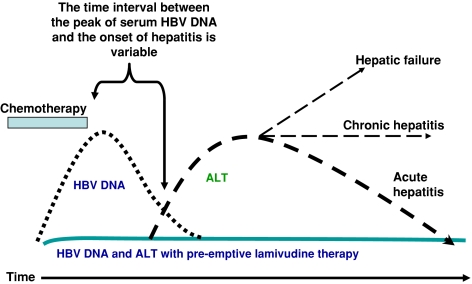Fig. 1.
Hepatitis due to HBV reactivation is a 2-phase process. The initial phase is related to intense immunosuppression caused by the cytotoxic therapy and is characterized by an enhanced HBV viral replication. There is a marked increase in serum HBV DNA level and viral protein expression in the hepatocytes. The second phase occurs during immune restoration on withdrawal of the chemotherapy and is marked by a much enhanced host immune response against HBV-laden hepatocytes, resulting in liver damages of varying severity, from hepatitis to hepatic failure and even death (solid line). The use of nucleoside analogues with anti-HBV activity in the initial phase could effectively prevent viral replication enhancement and therefore reduce the incidence of HBV-related hepatitis (dotted line)

